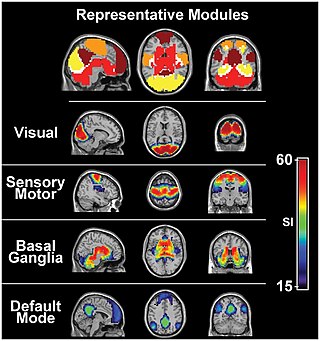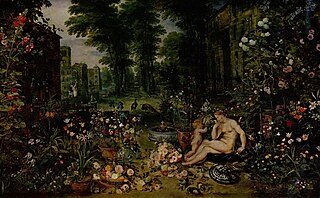Related Research Articles

The sensory nervous system is a part of the nervous system responsible for processing sensory information. A sensory system consists of sensory neurons, neural pathways, and parts of the brain involved in sensory perception and interoception. Commonly recognized sensory systems are those for vision, hearing, touch, taste, smell, balance and visceral sensation. Sense organs are transducers that convert data from the outer physical world to the realm of the mind where people interpret the information, creating their perception of the world around them.
Stimulus modality, also called sensory modality, is one aspect of a stimulus or what is perceived after a stimulus. For example, the temperature modality is registered after heat or cold stimulate a receptor. Some sensory modalities include: light, sound, temperature, taste, pressure, and smell. The type and location of the sensory receptor activated by the stimulus plays the primary role in coding the sensation. All sensory modalities work together to heighten stimuli sensation when necessary.

The olfactory system or sense of smell is the sensory system used for smelling (olfaction). Olfaction is one of the special senses, that have directly associated specific organs. Most mammals and reptiles have a main olfactory system and an accessory olfactory system. The main olfactory system detects airborne substances, while the accessory system senses fluid-phase stimuli.
Aromachology is the study of the influence of odors on human behavior and to examine the relationship between feelings and emotions. Those who practice aromachology are aromachologists. Aromachologists analyze emotions such as relaxation, exhilaration, sensuality, happiness and well-being brought about by odors stimulating the olfactory pathways in the brain and, in particular, the limbic system. Different wearers are thought to have unique physiological and psychological responses to scents, especially those not manufactured synthetically but based on real scents. The word "aromachology" is derived from "aroma" and "physio-psychology", the latter being the study of aroma. This term was coined in 1989 by what is now the Sense of Smell Institute (SSI), a division of The Fragrance Foundation. The SSI defines aromachology as "a concept based on systematic, scientific data collected under controlled conditions". The term is defined as the scientifically observable influence of smell on emotions and moods. Consumers use aromachology to alleviate time pressures, for relaxation or stimulation and as a component of other activities that generate a feeling of well-being.
In medicine and anatomy, the special senses are the senses that have specialized organs devoted to them:

The olfactory tubercle (OT), also known as the tuberculum olfactorium, is a multi-sensory processing center that is contained within the olfactory cortex and ventral striatum and plays a role in reward cognition. The OT has also been shown to play a role in locomotor and attentional behaviors, particularly in relation to social and sensory responsiveness, and it may be necessary for behavioral flexibility. The OT is interconnected with numerous brain regions, especially the sensory, arousal, and reward centers, thus making it a potentially critical interface between processing of sensory information and the subsequent behavioral responses.
In perceptual psychology, a sensory cue is a statistic or signal that can be extracted from the sensory input by a perceiver, that indicates the state of some property of the world that the perceiver is interested in perceiving.
The mismatch negativity (MMN) or mismatch field (MMF) is a component of the event-related potential (ERP) to an odd stimulus in a sequence of stimuli. It arises from electrical activity in the brain and is studied within the field of cognitive neuroscience and psychology. It can occur in any sensory system, but has most frequently been studied for hearing and for vision, in which case it is abbreviated to vMMN. The (v)MMN occurs after an infrequent change in a repetitive sequence of stimuli For example, a rare deviant (d) stimulus can be interspersed among a series of frequent standard (s) stimuli. In hearing, a deviant sound can differ from the standards in one or more perceptual features such as pitch, duration, loudness, or location. The MMN can be elicited regardless of whether someone is paying attention to the sequence. During auditory sequences, a person can be reading or watching a silent subtitled movie, yet still show a clear MMN. In the case of visual stimuli, the MMN occurs after an infrequent change in a repetitive sequence of images.
A topographic map is the ordered projection of a sensory surface, like the retina or the skin, or an effector system, like the musculature, to one or more structures of the central nervous system. Topographic maps can be found in all sensory systems and in many motor systems.

An odor or odour is caused by one or more volatilized chemical compounds that are generally found in low concentrations that humans and many animals can perceive via their sense of smell. An odor is also called a "smell" or a "scent", which can refer to either an unpleasant or a pleasant odor.

The sense of smell, or olfaction, is the special sense through which smells are perceived. The sense of smell has many functions, including detecting desirable foods, hazards, and pheromones, and plays a role in taste.
Olfactory memory refers to the recollection of odors. Studies have found various characteristics of common memories of odor memory including persistence and high resistance to interference. Explicit memory is typically the form focused on in the studies of olfactory memory, though implicit forms of memory certainly supply distinct contributions to the understanding of odors and memories of them. Research has demonstrated that the changes to the olfactory bulb and main olfactory system following birth are extremely important and influential for maternal behavior. Mammalian olfactory cues play an important role in the coordination of the mother infant bond, and the following normal development of the offspring. Maternal breast odors are individually distinctive, and provide a basis for recognition of the mother by her offspring.
Neuroscientists have learned much about the role of the brain in numerous cognitive mechanisms by understanding corresponding disorders. Similarly, neuroscientists have come to learn much about music cognition by studying music-specific disorders. Even though music is most often viewed from a "historical perspective rather than a biological one" music has significantly gained the attention of neuroscientists all around the world. For many centuries music has been strongly associated with art and culture. The reason for this increased interest in music is because it "provides a tool to study numerous aspects of neuroscience, from motor skill learning to emotion".
Odour is sensory stimulation of the olfactory membrane of the nose by a group of molecules. Certain body odours are connected to human sexual attraction. Humans can make use of body odour subconsciously to identify whether a potential mate will pass on favourable traits to their offspring. Body odour may provide significant cues about the genetic quality, health and reproductive success of a potential mate.

Sniffing is a perceptually-relevant behavior, defined as the active sampling of odors through the nasal cavity for the purpose of information acquisition. This behavior, displayed by all terrestrial vertebrates, is typically identified based upon changes in respiratory frequency and/or amplitude, and is often studied in the context of odor guided behaviors and olfactory perceptual tasks. Sniffing is quantified by measuring intra-nasal pressure or flow or air or, while less accurate, through a strain gauge on the chest to measure total respiratory volume. Strategies for sniffing behavior vary depending upon the animal, with small animals displaying sniffing frequencies ranging from 4 to 12 Hz but larger animals (humans) sniffing at much lower frequencies, usually less than 2 Hz. Subserving sniffing behaviors, evidence for an "olfactomotor" circuit in the brain exists, wherein perception or expectation of an odor can trigger brain respiratory center to allow for the modulation of sniffing frequency and amplitude and thus acquisition of odor information. Sniffing is analogous to other stimulus sampling behaviors, including visual saccades, active touch, and whisker movements in small animals. Atypical sniffing has been reported in cases of neurological disorders, especially those disorders characterized by impaired motor function and olfactory perception.
Multistable auditory perception is a cognitive phenomenon in which certain auditory stimuli can be perceived in multiple ways. While multistable perception has been most commonly studied in the visual domain, it also has been observed in the auditory and olfactory modalities. In the olfactory domain, different scents are piped to the two nostrils, while in the auditory domain, researchers often examine the effects of binaural sequences of pure tones. Generally speaking, multistable perception has three main characteristics: exclusivity, implying that the multiple perceptions cannot simultaneously occur; randomness, indicating that the duration of perceptual phases follows a random law, and inevitability, meaning that subjects are unable to completely block out one percept indefinitely.
George William Septimus Piesse, known as Septimus Piesse, was an English chemist and perfumer. Piesse was a leading author and innovator of modern perfume ideas, inventing the concept of notes in perfumery that are still used universally today. He was the co-owner of Piesse and Lubin, a perfume house that created some of the most popular scents of its day.
Olfactory heritage is an aspect of cultural heritage concerning smells that are meaningful to a community due to their connections with significant places, practices, objects or traditions, and can therefore be considered part of the cultural legacy for future generations.

Olfactory language refers to language associated with the sense of smell. It involves the naming and categorisation of odours by humans according to each odour's perceived source or attributes. The study of olfactory language is part of the field of linguistics and is distinct from the study of semiochemical communication, which involves communication between organisms using chemical substances detected through olfaction.

Olfactic communication is a channel of nonverbal communication referring to the various ways people and animals communicate and engage in social interaction through their sense of smell. Our human olfactory sense is one of the most phylogenetically primitive and emotionally intimate of the five senses; the sensation of smell is thought to be the most matured and developed human sense.
References
- ↑ Nathan S Kline Institute for Psychiatric Research, Staff List, accessed 25 February 2010
- ↑ Journal of Neuroscience Smelling Sounds: Olfactory–Auditory Sensory Convergence in the Olfactory Tubercle Daniel W Wesson and Donald A Wilson, 24 February 2010, accessed 25 February 2010
- 1 2 Scientific American, Making scents of sounds Lynne Peeples, 23 February 2010, accessed 25 February 2010
- ↑ The Art of Perfumery G. W. Septimus Piesse, London, 1862, p 25